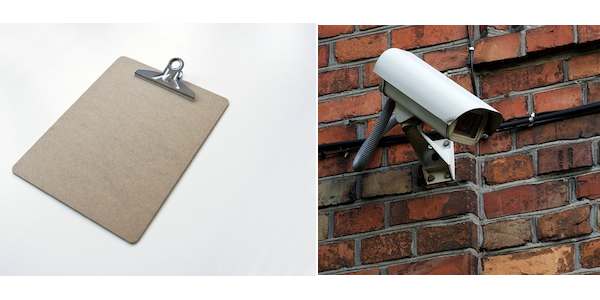
What are some new or creative sources of hard-to-get data, such as occupancy or load schedules?
-Playing hard to get
Dear Playing,
I’m happy to suggest a few “creative” sources of data for you to play with. You’ll have to judge whether they’re appropriate for your work!
Let’s start with occupancy schedules. Suppose we want to derive them from the behavioral patterns that occur in an existing building. Our first instinct may be to explore the various technological solutions at our disposal: passive infrared motion sensors, carbon dioxide sensors, pressure sensing floor mats, RFID badges, WiFi location tracking, video cameras, etc. But deploying these technologies is a significant undertaking that may not be practical for a typical energy modeling project.
Sometimes the simplest solutions are the best. Here are a few alternatives to installing a sensor network.
1. The Clipboard Method. This approach is as simple as it gets. One or more people with clipboards observe human activity in a building and write down whatever information is needed. For example, they could record the number of people in every room once per hour.
The clipboard method seems obvious to me now, but I hadn’t even considered it until I saw a keynote talk by Technion architecture professor Yehuda Kalay. His research group had obtained permission from several doctors to have students with clipboards follow them around during the day and record their activities. The purpose of that effort was to inform the layout of hospital wards, but one can imagine similar approaches being employed for energy modeling.
2. The Webcam Method. People may not appreciate being observed by other people. The idea behind the webcam method is to have people observe themselves, particularly in office environments.
Participants are provided with a licence for a webcam surveillance app, of which there are many affordable options online. They then configure the software to record video whenever they arrive at or depart from their desks. Participants review their own surveillance logs at the end of the day, and manually prepare a spreadsheet with the required data. The process takes a bit of practice and dedication, but it works.
3. The Wisdom-of-the-Crowd Method. The idea is to assemble a diverse group of participants who are familiar with a building environment, and have them simply make up whatever information is needed. For example, participants could independently suggest one or more occupancy schedules, and their contributions could be averaged.
Wait, what?! Make up information? Isn’t that unscientific?
Having one person make up information is unscientific. But having multiple people make up information can be considered a statistical approach. The human brain is a highly advanced pattern recognition and reproduction machine. It is also a highly biased machine, but this bias can be mitigated through diversity. If measured data is lacking, as it probably is, a diverse group of knowledgeable people might well be the best information source available.
Additional thoughts. The above methods are relevant for occupant behavior, which people have the ability to observe. But what about information that cannot be “seen” without measurement technology, such as plug or equipment loads? For lack of a better answer, inverse modeling strikes me as a promising research area that allows people to “measure” data indirectly.
While standard schedules are available, the energy modeling community should develop practical alternatives which better account for the diverse settings and behaviors that exist in our changing world. In the meantime, you must decide how much energy to invest in “hard-to-get” data, and how much creativity is appropriate.
Rhys Goldstein
Principal Research Scientist, Autodesk Research
rhys.goldstein@autodesk.com
Do you have anything to add or your own answer to contribute? Please share your thoughts by emailing askamodeler@ibpsa.us; you are an expert too! Do you have your own question for the expert? Submit your question to be considered for a future column. Note that questions requiring an immediate response should be submitted to the community of experts at unmethours.com. If you are interested in replying to a question as a featured expert or have any other feedback about Ask a Modeler please email askamodeler@ibpsa.us.


